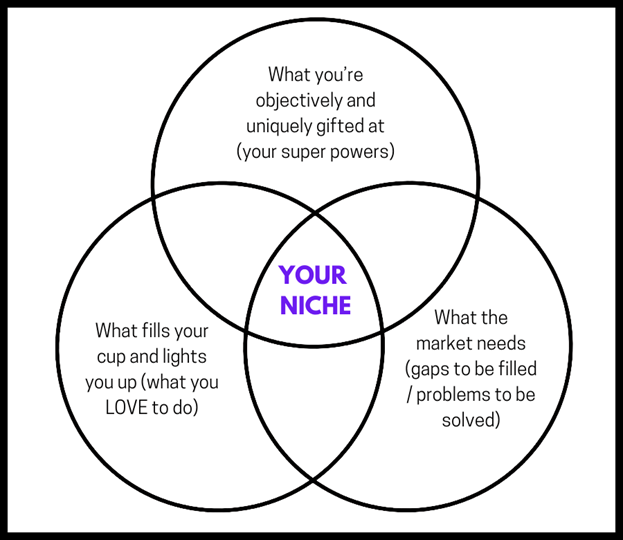There’s never been a better time to build an independent consultancy. However, I see my fellow senior communicators making an easily fixable mistake when they decide to go solo. They position themselves broadly, highlighting their many years (or decades) of experience across the full spectrum of the marketing communications landscape. Essentially, they’re claiming to be able to do it all.
When I counsel senior communications professionals about going out on their own, I always start by sharing a writing exercise. It begins with reviewing this little Venn diagram I created.

Think about each circle as a prompt for a one-hour free writing or brainstorming session. We communicators tend to love a good journaling assignment.
Circle 1: What You’re Objectively Gifted At
Without overthinking it or censoring yourself, write about anything and everything you’ve ever been complimented for. Think about the feedback you consistently receive, whether it’s praise from superiors, performance reviews, accolades and awards, as well as comments from friends and loved ones. Take note of everything you know for certain you excel at — skills, strengths, or qualities that set you apart from others. Don’t just rely on what you think is true or what you’d like to be true. List what you know to be true. Include not just your professional gifts, but your personal gifts too. If you’re an exceptional listener or supremely talented at line dancing, write it down.
Circle 2: What Fills Your Cup or Lights You Up
Again, without overthinking it, censoring, or judging yourself, write about everything that you absolutely love to do. Think about the activities that get you pumped to hop out of bed in the morning. Activities that put you into the “flow” state where you begin to lose track of time. What did you love doing as a kid? Have you carried it through into your adulthood? What do you get excited about now? Again, include not just your professional interests but your personal ones too. If you absolutely adore animals, or you love spending time in nature, write it down.
Circle 3: What the Market Needs — the Gaps to be Filled
This prompt begins with a little bit of homework:
- Pretend to be a client who might be interested in working with a communications consultant and open a new browser tab on your computer.
- In a search engine, and then on LinkedIn, begin searching and browsing for communications consultants and communications support. Try out different keywords related to your professional background and interests.
- Review the results as if you’re a decision-maker. When you find a website or LinkedIn profile that stands out, ask yourself why. What jumps off the page about it? When you notice patterns, repeated terminology, and the same kind of consultant positioning again and again, ask yourself what you might do to stand out and get noticed.
After this initial competitive analysis, finish this part of the writing exercise. Brainstorm ideas for gaps to be filled and problems to be solved. What areas are oversaturated? Where are there potential opportunities? What do business leaders really need from communication experts that they’re not getting enough of?
The Final Step: Put it All Together
I bet you know what’s coming.
Now that you’ve written about these different topics, you’re going to look for the overlap or point of potential interconnection — the center of the Venn diagram. The thread that crosses through all three sections will become the start of a possible niche for your consultancy.
Here’s an example from my own life:
- Circle 1: I have a gift for research, especially qualitative research, where I excel at leading probing conversations and gathering valuable insights.
- Circle 2: I have a passion for talking with and learning about hardworking, everyday people who spend all day on their feet or working with their hands — they remind me of my dad.
- Circle 3: I don’t see many employee communications consultants who are hyper-focused on meaningfully understanding and reaching the frontline.
When I considered all this, a potential niche became clear for me: a consultancy built on qualitative assessment and meaningful connection with frontline employees. The goal would be to improve internal communications and enhance engagement and retention. Notice how this niche is not simply “employee communications consultant,” it’s much more specific than that.
This kind of specificity is a game-changer in our current consulting landscape, especially at the senior level.
You may think that you should cover all your bases by listing as many potential services as possible, and it may seem you’ll get more incoming calls that way. But in my experience, the exact opposite is true.
When you narrow your offering to meet a specific demand, you achieve three goals simultaneously:
- You immediately stand apart from tens of thousands of other generalized, full-service “seasoned, strategic communications consultants.”
- You become memorable — someone who stands out when needs arise in your wheelhouse. This won’t be just in the minds of prospective clients; fellow consultants will also know exactly how to partner with you and integrate you into their projects.
- You’re easier to refer out and recommend. Your contacts will know when, why, and how to introduce you for referrals.
If you’re a senior communication professional looking to build a profitable, in-demand consultancy, set it up the right way from the very start. As I’ve told many consulting-curious folks, you have to be willing to put a stake in the ground and stand by it.
If you claim to be great at everything, you’ll be remembered for nothing.